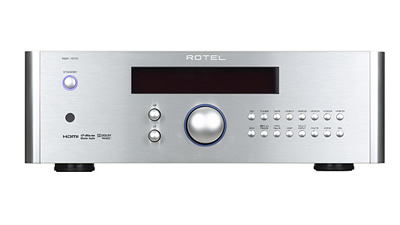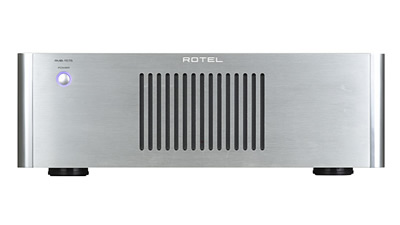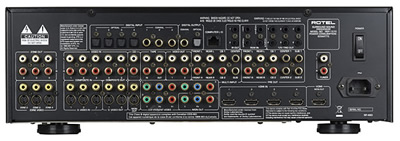|
Rotel's 15 Series: Audio Components to Lust AfterBy Jim Bray "More Power!" It's the clarion call of autophiles and audiophiles alike, and technological innovation is allowing both groups to get more for less all the time. A good example in the audio world is Rotel, which has been blazing a technological trail focusing on increasing the power output of amplifiers while decreasing their size, weight and energy use. And if the rest of the 15 series models are as good as the RMB-1575 I've been reviewing, Rotel's new Class D amps offer excellent ways to upgrade your oomph factor (and your green factor) substantially without sacrificing any audio quality. I've been using Rotel Class D power for a few years and like it so much I've even purchased some of their amps – 500 watt per channel powerhouses that feed my dedicated home theater and are an excellent match for my Epson 1080p LCD projector coupled with a 106 inch screen. I'd also been using a Rotel RMB-1077 (100 watts x 7) Class D amp in my "mainstream" home theater in the living room, an early Class D amp that has also performed beautifully. On their shoulders comes the 15 series, which includes not only a bunch of new Class D amps, but audio/video receivers and surround sound processors as well. The line sports a new look from the previous "10 series" components (though I must admit I liked the old look better), the amps offer plenty of power and the other components give you just about all the features you could need today. The RMB-1575 amplifier was a logical choice for me to try. While it offers two channels fewer of amplification than the RMB-1077, five channels is all I (and most people) run anyway, so losing two channels was hardly a hardship. But get this: the RMB-1575 cranks out an extremely healthy 250 watts per channel (20-20 kHz, 0.03% THD) into eight ohms or 500 watts into four ohms, which is more than enough oomph to power just about any home theater. I tried it in both of mine for this feature, but since I already have 500 watts per channel downstairs, I ended up using it mostly as the heart of our smaller home theater, where it made my 5.1 set of JBL ES series speakers sing – and thunder. It's a remarkable amp. Called "digital amps" at times, though it isn't really true, Class D amplifiers use ICEPower modules to achieve very high efficiency, lots of power and very little heat. They're also very light: the 250 watt RMB-1575 weighs just over 24 pounds. Compare that with the Rotel RMB-1095 "conventional" amp I used to use: a fine amp, with 200 watts per channel, but also with 75 pounds of hernia-inducing heft, more heat generation and more power consumption. Heck, with a Class D amp you can pay off your mortgage earlier, through lower electrical bills! Anyway, the $2799 RMB-1575 is yet another wonderful Class D amp from a company that appears to be staking its reputation increasingly on such technology. And good for them. I love the Rotel Class D amps I've tried. Not only do they have a wonderfully clean and wide open, transparent sound, but there's a "punch" to them that's really rewarding; they also make percussion and horns leap from the speakers, though not to the point that they overwhelm the rest of the music. The balance is wonderful, the sound very real. The RMB-1575 also matches beautifully with the $2199 RSP-1570 preamp/surround sound processor. The 1570 is the logical and spiritual successor to Rotel's RSP-1069, which was also a good unit within its "earlier generation" limitations. For example, with only HDMI 1.1 capability, the 1069 had to accept already-decoded audio signals from Blu-ray players (not a big deal since most BD players do that anyway – you just have to remember to set them accordingly), and it couldn't pass through film-based Blu-rays' 24 Hz signals. I get around this by using an external HDMI 1.3 switcher that lengthens the techno-generational shortcoming beautifully. But the RSP-1570, besides sporting the new 15 series look, also ups the technological ante by being fully HDMI 1.3 compliant and offering 1080p/24 Hertz capability along with onboard processing for the new "high def" audio formats of dts HD Master Audio and Dolby TrueHD. It's really the full meal deal: four HDMI 1.3 inputs (and one output), Faroudja technology to up convert standard definition sources to 1080p, with dual 32 bit DSP processing and 24 bit/192kHz digital-to-analog converters, and it supports the new “Deep Color” and xvYCC video options (which may never become a big deal but which must be supported to be competitive). So you can hook in up to four high def HDMI sources and output them to your HDTV with full fidelity. I did have some HDMI handshaking issues with the RSP-1570, but I've had handshaking issues with just about every HDMI switching component I've tried, including dedicated switchers. I suspect it's due to the copy protection forced on the HDMI standard by Hollywood, which causes components to verify that everything's legal and above board between them before they'll pass through the signals. Big Brother, indeed! And you thought you had rights when you purchased a product! The RSP-1570 also includes rear panel bi-directional RS-232 ports, assignable 12-volt triggers and multiple IR connections so you can use it as the brain for a multi-room system. It supports 7.1 channels but, naturally, is perfectly content to work with 5.1 (and stereo, of course). It's also quite a handsome component, though I have a quibble with the bright blue light that surrounds the power buttons on 15 series stuff – they're nearly bright enough to read by and this is annoying in a front projection theater where light is an issue. It's kind of cool in the living room, though. As is typical with Rotel preamp/processors – and receivers – the unit has enough inputs to choke the proverbial horse. Besides the HDMI connectors there are conventional (composite and S-Video) video inputs, component video inputs, coax and optical digital inputs, and analog audio inputs. In short, there isn't much you can't hook in here – which of course is the way it should be. Likewise for outputs. You can send video to your TV via HDMI or component (though you can only get 1080p via HDMI, which is normal), or to old fashioned TV's via component or S-connector. I use a component output to connect an old CRT TV so I can access the RSP-1570's on screen menus and/or DVD-Audio disc menus without having to fire up the big projection screen; it not only works beautifully, it keeps a once state-of-the-art Sony XBR TV out of the landfill.
The preamp/processor also lets you run stereo analog signals straight through, in bypass mode, avoiding any processing, and it accepts up to 7.1 channels of analog audio inputs, which means you can run the output from a DVD-Audio and/or SACD player into it directly – and they'll sound spectacular. I wish they'd start putting two such sets of analog inputs, since I'm never satisfied, but I also don't know where they'd find room on the back panel. Why bother with analog at all? Well, when I A/B'd DVD-A and SACD signals via analog and HDMI, the analog connection sounded richer, clearer and louder. I haven't reviewed a Blu-ray player with analog outputs yet, so haven't had a chance to see how Dolby TrueHD and dts Master Audio playback will perform connected that way; fortunately those audio formats sound superb via HDMI. I listened to the preamp and the amp separately (in different systems) as well as patched together and liked it best when they worked as a team. Not that they sucked separately, but they're matched very well and look good together. Regardless of where you use it, it's hard to argue against the RMB-1575's 250 watts of lovely oomph, and the RSP-1570's terrific flexibility and sonic performance. I listed to a wide variety of music, from the SACD of "Dark Side of the Moon" and DVD-A discs from Les Brown and his Band of Renown, Dire Straits and others, to the most dynamic CD I can think of (the remastered The Who Live at Leeds) and even some vinyl LP's, the latter of which requires an outboard turntable preamp. I also tried audio-friendly Blu-rays such as TrondheimSolistene's "Divertimenti" (a music only disc), Ray Charles Live at Montreux (an excellent concert for video and audio quality), and "reference quality" movies like "The Dark Knight", "A Bug's Life" and many others. I love my job! As is typical of Rotel, in my experience, the 15 series equipment didn't favor one type of audio over another – by which I mean it can't be thought of as "great for movies" or "great for music" because it's great for both. You hear every nuance (including stuff I've never heard before from recordings I've owned for years), and the sound is clear, clean and crisp without shrillness or harshness. Channel separation is first rate and once you've balanced the system correctly (which is easy thanks to a set of straightforward menus on the preamp/processor), you're in for an aural feast. One thing the RSP-1570 doesn't do is offer an internal system for calibrating itself to your listening room, which would probably be handy. But it's easy enough to use an inexpensive sound pressure level meter in concert with Rotel's menu-driven calibrations (and maybe a tape measure, to set the speaker delays) and do it yourself in a few minutes. The RMB-1575 and RSP-1570 were my first experience with Rotel's new 15 series. If the rest of them are as good, the company has come up with yet another winning line of components that offer excellent sound and build quality for a reasonable price. Copyright 2009 Jim Bray Update, January 30, 2010: comments from reader savant-noir: I hope you have good ears because I just purchased (2) RMB-1575's and (2) RMB-1572's along with (1) RSP-1570 sight unseen (or, ears unheard). Not the most prudent way to buy audio gear I know, but I have been an audiophile consumer for 25 years, and I have come to the following conclusion in the home theater world: Unless your name is Bill Gates, I have grown weary of buying $20,000 processors and $10,000 DVD players, just to wring out an extra 3% of gee-whiz effect, and then have it be obsolete 6 months later. Case in point: A few years back bought Arcam FMJ P-7, AV-9, and DV-139. This electronic front-end retails for about 15k. Today one could buy a $5,000 Marantz front end system that sounds infinitely better, if for no other reason that it can play all the lossless codecs. Irrespective of how much one pays for the super high end, in the final analysis the biggest bang for your buck will always be your speakers and the room itself....so...this brings me to the rationalization of today's purchase... I have no floor footprint space, so have (7) Martin-Logan Voyages installed in my current 7.3 system. I just purchased 14-ch worth of 250 watts because I am upgrading my speakers to the Wisdom Audio P-38's. These speakers can ONLY be run in a bi-amped fashion, with the ability to handle 1,000 watts each. The lacking of room correction I deem a bonus in the RSP-1570. Let's face it, when the Audyessey stand alone equalizer sells for $2,500, the software they license to all these people selling entire receivers for less than that, is really not much more than gimmickry. With the Wisdom Audio, their SC-1 Controller must also be purchased with the speakers. This unit is the full-fledged hardware Audeyssey equalizer (and then some), coupled with Wisdom Audio's active cross-overs for each speaker. Could the sound be better with Burmiester, Levinson, or Krell amps? In my room that possibility remains marginal at best. With tons of power that the Rotel offers, coupled with all the latest decoding features, I think I have finally come to a place in life where I have arrived at audio Nirvana. Six months from now if there are new formats, you can easily replace the processor and even if you gave it away, you still haven't lost even a fraction of what it would cost if one were trying to get rid of their old $6,500 AV-9 (for an example). This Rotel solution is my way of keeping in the loop, negating costly re-do's, while still enjoying the benefits of what excellent speakers can do. I can hardly wait for it to arrive! Jim Bray's columns are available through the TechnoFile Syndicate. We welcome your comments! |
|
|||||



 The RSP-1570 decodes these audio formats: Dolby Digital, Dolby Digital EX, Dolby Prologic IIx, dts, dts_ES,dts96/24, LPCM (up to 192K), Dolby TrueHD and dts HD Master Audio, which should be enough for anyone. There are also some "digitally fudged" surround settings I can take or leave.
The RSP-1570 decodes these audio formats: Dolby Digital, Dolby Digital EX, Dolby Prologic IIx, dts, dts_ES,dts96/24, LPCM (up to 192K), Dolby TrueHD and dts HD Master Audio, which should be enough for anyone. There are also some "digitally fudged" surround settings I can take or leave.